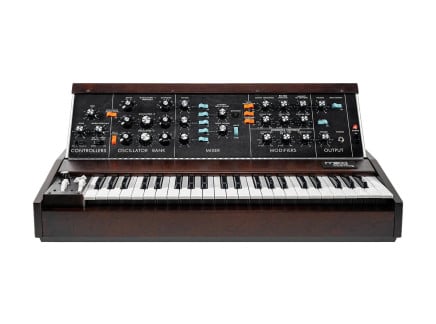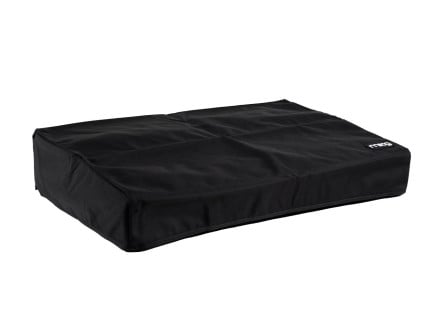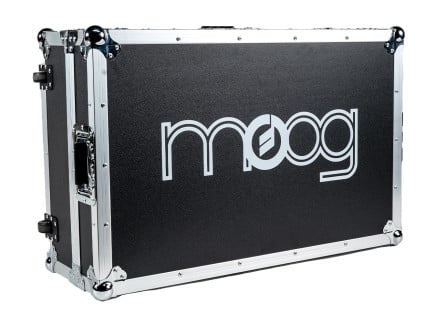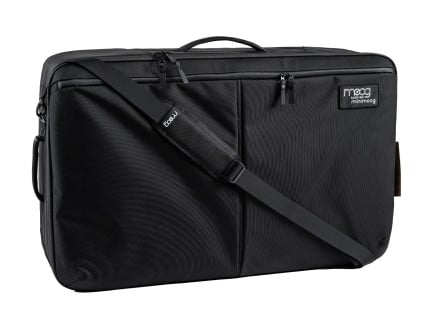If you're at all familiar with the history of electronic musical instruments, then you probably know: the Moog Minimoog Model D is, undoubtedly, one of the most significant synthesizers of all time. Its sound and its look are unmistakeable—and its DNA can be found in nearly every commercial synthesizer developed since its 1970 release.
Today, we're thrilled to announce that the Minimoog is back. Moog Music has resumed production of this world-changing instrument, with sound and performance that is faithful to the original while adding some minor quality-of-life updates that should make it quite at home in modern studios and performance environments. If you want the sound and performance of a classic Model D, don't hesitate: this synth is the real deal. Built by hand in the USA in small numbers, this synth is built to deliver top-notch sound and a joyful playing experience for decades to come.
Of course, I can't help but look at the release of such an exceptional and historically significant instrument without taking a brief look back at its history and influence. If you're specifically looking for details about the new 2022 edition of the Model D, feel free to jump ahead—but if you want a nostalgic trip down memory lane, or a refresher on just how influential the Minimoog was, read on.
The Dawn of the Minimoog
In the 1960s, the music world was shaken by the introduction of the Moog modular synthesizer system. For reasons that we've discussed extensively before, the Moog positively took the popular music world by storm: it presented a universe of entirely new sonic possibilities coupled with an interface that made it (relative to other contemporary instruments) fairly approachable to composers. This coupled with its early adoption by some truly outstanding musicians—think Wendy Carlos, Stevie Wonder, Paul Beaver, Bernie Krause, and countless others—made it such that the Moog system quickly defined a sonic standard. By 1970, the sound of the Moog synthesizer was familiar to most music listeners, and suddenly, despite only existing for a few years, it was clear that the synthesizer had a strong place in the world of popular music (and an exciting future ahead of it).
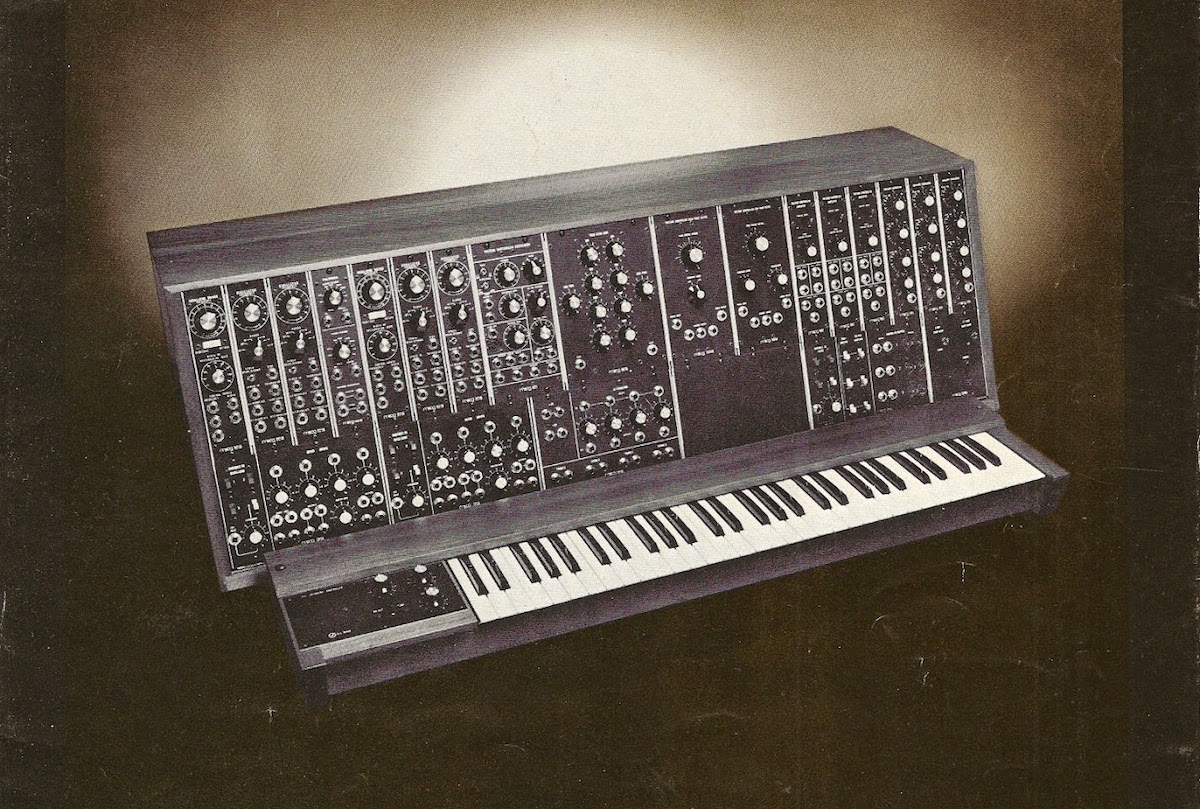
Originally, though, the Moog modular synthesizer was developed as a tool for experimental music composition well outside the realm of rock and pop music. The Moog system's open-endedness granted composers the ability to explore new sounds by restructuring the instrument's own internal organization. That's the point of a modular synthesizer: using patch cables, users can significantly alter the instrument's sound and behavior, allowing for everything from now-familiar synth basses and leads to heavy drones and experimental, self-generating soundscapes. However, this flexibility means that modular synthesizers are also notoriously complex to use—if you approach one with no prior knowledge of synthesis, you're unlikely to get results you'll enjoy very quickly. And in the 1960s, being that the synthesizer was entirely new, very few musicians had enough prior knowledge to simply sit down at a Moog modular system and immediately start making music.
So, while the Moog modular system did present a somewhat more approachable interface than other contemporary devices, and while dedicated keyboardists and composers did learn to use it to quite musical effect, it still wasn't absolutely immediate to most musicians. This, coupled with its relatively high price tag, meant that—despite the fact its sonic capabilities were becoming quite clear to the general public—most musicians simply couldn't make use of one. Keep that idea in mind.
Meanwhile (c. fall 1969), while Moog's company was busy building modular systems for universities, studios, and private musicians, something absolutely world-changing was happening under their own roof. The idea of producing a portable synthesizer was already in the air—but Bob Moog himself wasn't pursuing the idea directly. Instead, as he was busy giving lectures and running a company, his engineering team were free to tinker, experimenting with new ideas as they came along. Much in this spirit of exploratory discovery, staff engineer Bill Hemsath spent his lunch hours tinkering—picking through the company's "graveyard" of abandoned parts, cases, keyboards, and burned-out circuit boards.
Hemsath and fellow engineer Jim Scott had worked on a previous Moog project involving the creation of a rudimentary preset system for Moog's modular systems, specifically for use at a concert at MOMA. Through their own use and with consultation from musicians like Chris Swansen and David Borden, they collectively gained an understanding of how one might conceptualize a "standard" synthesizer patch.
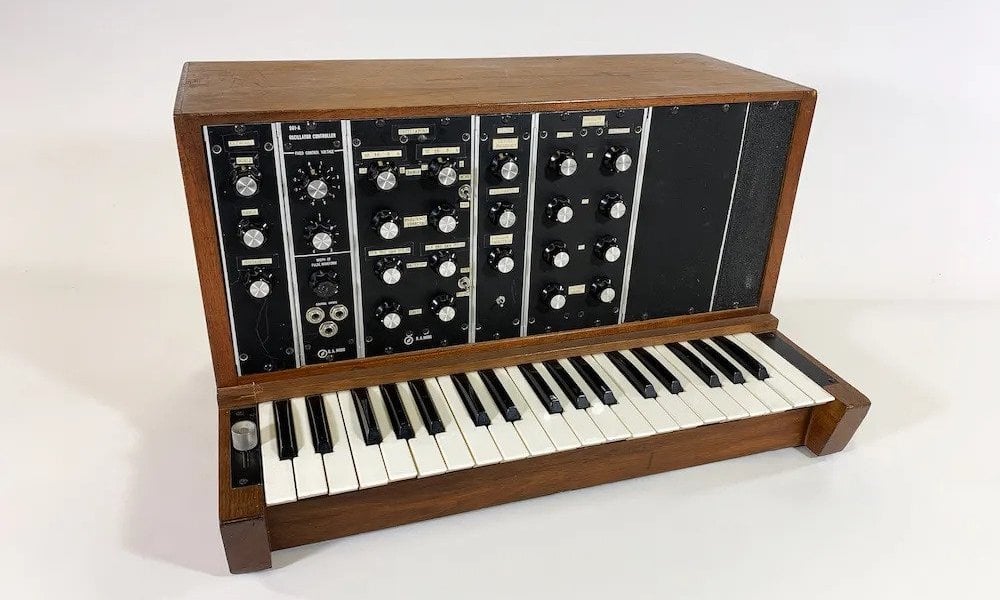
Gradually, Hemsath accumulated enough junk from the Moog "graveyard" to cover the bases of a "typical" patch. Complete with case, keyboard, and glue, he was able to assemble what he called the Model A Min: a relatively compact instrument with a keyboard and Moog modules in the same cabinet (unlike Moog's modular instruments). There were no patch cables required: the Model A made all signal connections behind the panel, leaving only front-panel knobs, a keyboard, and a single left-hand slide potentiometer as a playing interface. The thing is—this instrument was just Hemsath's pet project, and it wasn't yet clear to him, his fellow engineers, or to Bob Moog himself how important it would be. (The Model A Min Moog is pictured above—image via Google Arts & Culture and EMEAPP, current stewards of several prototype Minimoogs.)
Without getting into the weeds, it's fair to say that, at this time, Moog's company wasn't entirely financially stable. Money was tight, and their workforce knew it—and as such, the engineers took a lot of initiative in pushing new designs forward, often without Bob Moog's full permission. There was a lot of talk around the factory about the potential of a more affordable, portable synthesizer: something that they could mass produce in order to help dig themselves out of a financial hole. So Hemsath eventually revisited his personal project in order to create the Model B: a streamlined, much cleaner-looking instrument with all components behind a single front panel. Overall, this prototype instrument was much sleeker than the Model A, and though it never went into production as such, it incidentally found great use in Sun Ra's music. Overall, the Model B's strong suits were enough to convince Bob Moog that the project was worth pursuing. (See the Model B and Model C below—again, images via Google Arts & Culture and EMEAPP.)
Together, Moog, Hemsath, Scott, and others set out to re-design, simplify, and stabilize the circuits from their modular system for use in this portable, self-contained instrument. The new filter, amplifier, and envelope circuits were considerably simpler and more affordable to produce, and the new oscillator design was much more temperature-stable than prior iterations. The Model C prototype debuted the iconic flip-up control panel, and introduced the now-ubiquitous combination pitch bend/modulation controls found in the left-hand controller (LHC) section.
Before heading off on a trip, Bob Moog instructed his staff to build ten additional hand-wired Model C prototypes—but, slightly against his wishes, his engineers instead laid out circuit boards and built the first Model Ds. Moog himself wasn't thrilled at first—but despite his frustration, and despite the fact that they had originally intended to do one more design revision, the Model D was a manufacturable, complete, and already a quite excellent instrument. And so, it went into production, and was first introduced to the public at the October 1970 Audio Engineering Society (AES) convention. The Minimoog was a huge success—over 12,000 instruments were built over the course of the 1970s, and music hasn't been the same since.
The Minimoog's Legacy
So, we know where the Minimoog came from...but why was it such a hit? Frankly, that's a huge question—but a good one, and one we'll probably be asking for decades more to come. Partly it has to do with the look: the all-wood chassis and hinged, tilting control panel are a look that has been mimicked by countless instrument designers in the ensuing decades. Partly, it had to do with the sound, of course: the combination of three ever-so-slightly drifty oscillators and the significantly overdriven ladder filter create the opportunity for thunderous bass sounds, in-your-face leads, and compelling, evolving sonic textures. And of course, the price was a mere $1995 at the point of its introduction: a fraction of what you'd pay for a Moog modular system.
However, I don't personally think that the look, sound, and price alone are what made the Minimoog so special. The price no doubt ultimately got it into the hands of more musicians than would have been possible otherwise, but what made it stick was its all-around user experience. The Minimoog, perhaps more than any synthesizer that preceded it, was highly playable and approachable, and could be easily learned by any musician within a single sitting. Its self-contained form meant that Moog could provide patch sheets, helping people to get started—but honestly, with such a limited set of controls, such direct/clear labeling, the elimination of patch cables, and the surprisingly small number of ways in which it could be made to do nothing, the Minimoog gave musicians something new to explore every time they sat down at it. No longer faced with the endless possibilities of a modular synthesizer and no longer burdened with the necessity of deep synthesis knowledge, musicians were finally free to explore synthesis and learn by playing music. The front panel, despite having the same sorts of controls you'd find on a Moog modular system, was singular enough to feel considerably less intimidating. The left-hand controllers provided the opportunity for easily expressive playing; they keyboard provided familiar grounding for keyboardists and composers; and from there, musicians were free to explore the engrossing sounds that it had to offer.
The Minimoog would find its way into more music than we could possibly list here. It was perhaps most masterfully played by Bernie Worrell of Parliament-Funkadelic; it became a go-to axe for solo progressive rock keyboardists like Keith Emerson and Rick Wakeman; it helped define the future sound of electronic music through the work of Kraftwerk, Devo, Gary Numan, and so many others; it eventually became a staple part of the sound of hip-hop and G-funk through the work of Dr. Dre.
Of course, the Minimoog has come back several times throughout the decades: first as the Minimoog Voyager, one of synthesizers that started the modern Renaissance of analog synthesizer production altogether. The Voyager was available in many iterations, from the stripped-back yet powerful Voyager Old School to the feature-laden Voyager XL, each with their own unique take on the original Minimoog's signal flow and physical layout. However fantastic an instrument the Voyager was, though, it wasn't a 1:1 reproduction of the Model D: in fact, it never tried to be, instead acting as a turn-of-the-century re-envisioning of its classic predecessor.
In 2016, though, Moog answered many musicians' long-standing dream by resuming production of the classic Model D. The 2016 Model D captured the essence of the original and presented it in as true a form as possible; and today, we witness a yet newer entry into the Model D story.
2022: The Minimoog Model D Returns
It's 2022, and the Moog Model D is back. The current-issue Moog Minimoog Model D picks up exactly where the 2016 Model D left off, but adds some extra features not found in any prior version of Model D.
That said, let's start with the basics, just to get them out of the way. The Model D is built in Asheville, North Carolina using through-hole components. The analog circuit layout is identical to the original, right down to the placement of individual parts. It's assembled by real humans with real hands, requiring an enormous amount of skilled labor to produce. It swaps the classic walnut cabinet with walnut-stained, locally-sourced Appalachian cherry. This isn't some SMD-filled, built-by-robots, mass-produced Minimoog facsimile: this is a Minimoog down to the final details. Let's review some of those finer details, shall we?
The Model D's sound begins with three stable, wide-range oscillators with a variety of waveshapes available for each. Pitch is governed by octave range switches for each oscillator, with additional tuning offset knobs for oscillators two and three (great for creating stacked intervals that track the keyboard). Each oscillator can go into low-frequency range (helpful in a variety of audio effects and modulation scenarios), and oscillator three can be decoupled from the keyboard in order to drone or to act as a modulation source (more on that later!). Oscillators one and two offer triangle, "sharktooth," rising saw, square, narrow pulse, and very narrow pulse wave shapes; oscillator three dispenses of the sharktooth shape in favor of a falling saw wave.
The oscillators may be summed together in any combination in the mixer section, each with dedicated mute switches and volume controls. The mixer section also features a noise source (switchable between white and pink noise) with its own mute and volume controls, as well as volume and mute controls for an external input signal. Notably, this version of the Model D (and the 2016 version) feature a special trick in this section: it was common on vintage Minimoogs for artists to loop the instrument's output back into its external input in order to create feedback-based overdrive/distortion effects. Happily, this signal is normalled to the external input—meaning that you don't need to patch this up in order to achieve some truly brutal distortion tones. And in fact, overdrive/distortion is a key part of the Minimoog's sound: the filter itself has a significant gain boost, so even modest volume levels in the mixer can push it into warm, woolly overdrive. (You'll be grateful for the Overload indication lamp, trust us.)
Of course, that brings us to one of the most important sections overall: the filter itself. Originally re-designed by the aforementioned Jim Scott, the Minimoog's filter is a slight re-imagining of the transistor ladder lowpass filter found in vintage Moog modular systems. Famously due to a slight miscalculation, the filter is a bit overdriven: a factor that is often pointed toward in efforts to pin down what makes the Minimoog sound so special. The filter offers dedicated controls for cutoff frequency and resonance, as well as a dedicated "contour generator"—again, one of Scott's simplifications of Moog's classic designs, in this case, a pared-back take on the 911 envelope generator. Providing only controls for attack time, sustain level, and a sort of couple decay/release time control, this is a foundational aspect of the Minimoog's sonic punch. The VCA features its own dedicated contour generator, otherwise identical to that found in the filter section.
Finally, the front panel features a volume control, master mute switch, headphone output, and a switchable A-440 tuning oscillator—an insanely useful feature on an instrument that features variable oscillator tuning.
The Minimoog features a premium 44-key Fatar keybed with velocity and monophonic aftertouch (each accessible via back-panel/top-panel CV outputs). The left-hand controller section offers the expected glide and decay controls, as well as pitch bend and mod wheels. This version of the Model D is the first to incorporate a spring-return pitch bend wheel, allowing it to easily return to center position...a long-standing request among artists who grew up with later synthesizer designs.
The Controllers section is where much of the Minimoog's expressive magic lies: it's a place to control keyboard glide time, global tuning, and of course, modulation. The single modulation mix control allows you to blend between two selectable modulation sources—oscillator three or the filter envelope on the left, and noise or dedicated LFO on the right. The LFO itself was a new addition in the 2016 Minimoog, and quite a helpful one: in earlier versions, you had to drop the third oscillator into low-frequency range for vibrato, FM, or filter modulation effects, often sacrificing its use as a sound source. In this version, you have access to a triangle/square LFO separate from the audio oscillators, giving you greater freedom to create huge sounds without sacrificing modulation flexibility. Modulation can be sent to either the oscillator or filter via dedicated switches in their respective sections on the panel. This enables everything from filter wobbles to vibrato, chaotic noise sweeps to dual LFO madness: despite the simple ingredients, you can come up with quite a number of complex, playable sounds using this section.
The new Moog Model D also features significantly expanded interconnectivity potential. As mentioned before, there's plenty of CV I/O, including outputs for keyboard pitch, velociy, aftertouch pressure, and a standard gate/V-trig output for triggering external devices. There are external inputs for loudness, filter cutoff, and oscillator pitch, as well as an external mod source input and Gate/V-trig input for remotely triggering envelopes. So, you can connect the Minimoog to your favorite CV-capable external gear, be it an external CV sequencer, modular synthesizer, or hey—even a Moog semi-modular synth, perhaps.
And, not least of all, the modern Minimoog has dedicated MIDI In, Out, and Thru. Yep, it's capable of acting as a MIDI controller, or of being controlled via external MIDI. This is great for sequencing or for playback of recorded passages, of course—and happily, the keyboard/controllers send MIDI notes, velocity, aftertouch, and pitch and mod wheel messages for control of external instruments. Regrettably, MIDI input seems to be limited to note messages—but remember, the host of CV inputs are there to cover other external control scenarios.
A Continuing Legacy
We're celebrating a somewhat belated, yet huge landmark in the history of electronic instruments: in fall of 2020, the world reached the 50th anniversary of the Model D. Now two years later, we can say its impact is still felt across the synthesizer industry—not only because of the music it has been used on, but because of its influence on other instrument makers.
The ubiquity that the Minimoog achieved quite quickly in the 1970s made several would-be synthesizer makers turn their heads. Some makers (ahem, Tom Oberheim and Dave Smith) got their start in the synth business producing expansion devices for the Minimoog specifically, while others more immediately sought to produce instruments to compete with the Minimoog...many of which were formed fairly directly from the Minimoog mold itself.
It wouldn't be an understatement to say that most commercially-produced synthesizers available today still take an immense amount of design influence from the Minimoog. The tilted panel, the wood cabinet, the functional signal flow layout of the front panel, and even the specific choices of what sonic elements should be included—these influences are present in hardware, software, modular synths, keyboards, you name it.
It's remarkable to see what started as Bill Hemsath's lunchtime personal project have such lasting influence—amazing to see what passionate engineers at Moog managed to do without expressly having their boss's permission—and amazing to consider what will come next in the history of this fascinating, timeless instrument.

